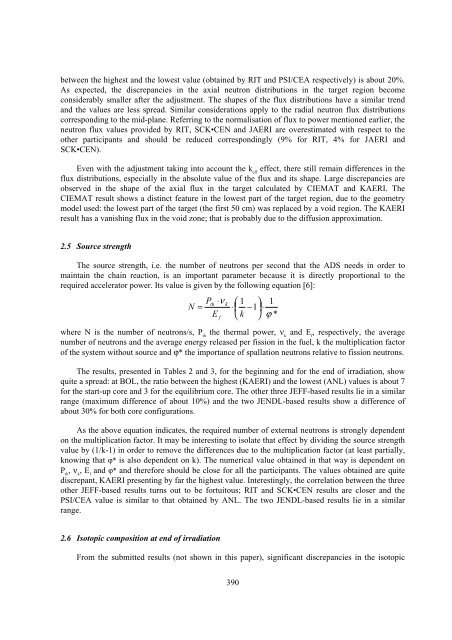OECD/NEA Benchmark Calculations for Accelerator Driven Systems
OECD/NEA Benchmark Calculations for Accelerator Driven Systems
OECD/NEA Benchmark Calculations for Accelerator Driven Systems
Create successful ePaper yourself
Turn your PDF publications into a flip-book with our unique Google optimized e-Paper software.
etween the highest and the lowest value (obtained by RIT and PSI/CEA respectively) is about 20%.<br />
As expected, the discrepancies in the axial neutron distributions in the target region become<br />
considerably smaller after the adjustment. The shapes of the flux distributions have a similar trend<br />
and the values are less spread. Similar considerations apply to the radial neutron flux distributions<br />
corresponding to the mid-plane. Referring to the normalisation of flux to power mentioned earlier, the<br />
neutron flux values provided by RIT, SCK•CEN and JAERI are overestimated with respect to the<br />
other participants and should be reduced correspondingly (9% <strong>for</strong> RIT, 4% <strong>for</strong> JAERI and<br />
SCK•CEN).<br />
Even with the adjustment taking into account the k eff<br />
effect, there still remain differences in the<br />
flux distributions, especially in the absolute value of the flux and its shape. Large discrepancies are<br />
observed in the shape of the axial flux in the target calculated by CIEMAT and KAERI. The<br />
CIEMAT result shows a distinct feature in the lowest part of the target region, due to the geometry<br />
model used: the lowest part of the target (the first 50 cm) was replaced by a void region. The KAERI<br />
result has a vanishing flux in the void zone; that is probably due to the diffusion approximation.<br />
2.5 Source strength<br />
The source strength, i.e. the number of neutrons per second that the ADS needs in order to<br />
maintain the chain reaction, is an important parameter because it is directly proportional to the<br />
required accelerator power. Its value is given by the following equation [6]:<br />
Pth<br />
⋅ν<br />
k ⎛ 1 ⎞ 1<br />
N = ⋅⎜<br />
−1⎟ ⋅<br />
E ⎝ k ⎠ ϕ *<br />
f<br />
where N is the number of neutrons/s, P th<br />
the thermal power, ν k<br />
and E f<br />
, respectively, the average<br />
number of neutrons and the average energy released per fission in the fuel, k the multiplication factor<br />
of the system without source and ϕ* the importance of spallation neutrons relative to fission neutrons.<br />
The results, presented in Tables 2 and 3, <strong>for</strong> the beginning and <strong>for</strong> the end of irradiation, show<br />
quite a spread: at BOL, the ratio between the highest (KAERI) and the lowest (ANL) values is about 7<br />
<strong>for</strong> the start-up core and 3 <strong>for</strong> the equilibrium core. The other three JEFF-based results lie in a similar<br />
range (maximum difference of about 10%) and the two JENDL-based results show a difference of<br />
about 30% <strong>for</strong> both core configurations.<br />
As the above equation indicates, the required number of external neutrons is strongly dependent<br />
on the multiplication factor. It may be interesting to isolate that effect by dividing the source strength<br />
value by (1/k-1) in order to remove the differences due to the multiplication factor (at least partially,<br />
knowing that ϕ* is also dependent on k). The numerical value obtained in that way is dependent on<br />
P th<br />
, ν k<br />
, E f<br />
and ϕ* and there<strong>for</strong>e should be close <strong>for</strong> all the participants. The values obtained are quite<br />
discrepant, KAERI presenting by far the highest value. Interestingly, the correlation between the three<br />
other JEFF-based results turns out to be <strong>for</strong>tuitous; RIT and SCK•CEN results are closer and the<br />
PSI/CEA value is similar to that obtained by ANL. The two JENDL-based results lie in a similar<br />
range.<br />
2.6 Isotopic composition at end of irradiation<br />
From the submitted results (not shown in this paper), significant discrepancies in the isotopic<br />
390

















